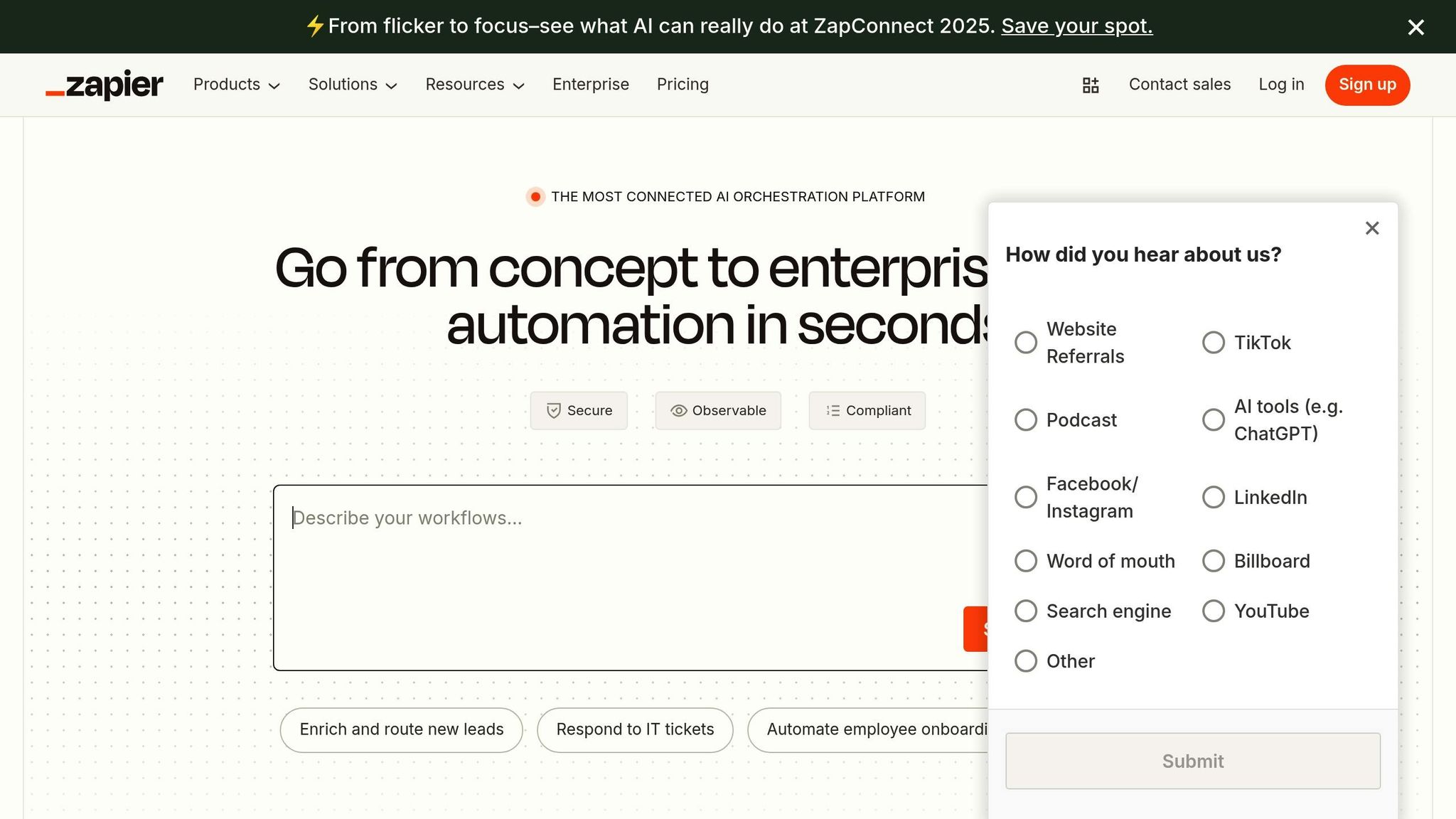Automation tools like Zapier and Make simplify repetitive tasks for developers by connecting apps and automating workflows. Here's the quick takeaway:
- Zapier is ideal for simple, fast setups. It uses a step-by-step interface and is beginner-friendly. Best for small-scale automations like syncing GitHub commits with Slack notifications.
- Make offers more control for advanced workflows. Its visual drag-and-drop interface supports complex logic, API integrations, and detailed error handling. Perfect for developers handling intricate tasks and large datasets.
Quick Comparison
| Feature | Zapier | Make |
|---|---|---|
| Ease of Use | Simple, form-based builder | Visual, drag-and-drop canvas |
| Workflow Steps | Up to 100 steps | Unlimited |
| Best For | Quick, simple automations | Complex, technical workflows |
| Pricing | Starts at $19.99/month | Starts at $9/month |
Choose Zapier for ease and speed. Pick Make for flexibility and detailed control. Your choice depends on your workflow complexity and technical needs.
Zapier vs. Make: Comparing Pricing, Integrations and More

Automation Features
When it comes to efficiency, the choice of automation platform can make a big difference for developers. Zapier and Make both enable task automation, but their distinct approaches to workflow design and functionality significantly influence what developers can achieve.
Workflow Design and Complexity
Zapier uses a straightforward, step-by-step structure. Its form-based builder makes setting up automations quick and easy. This design works well for tasks like sending Slack notifications for GitHub commits or syncing new Trello cards with a project dashboard. However, there’s a catch: Zapier limits workflows to a maximum of 100 steps. This can be restrictive if you need branching paths or intricate conditional logic.
Make takes a different route with its visual drag-and-drop interface. Instead of filling out forms, you use a canvas to arrange modules and connect them with lines that represent data flow. This approach provides a clear, hands-on view of how data moves through the automation, making it easy to tweak and refine. Make’s modular design is especially useful for building complex workflows - it supports unlimited steps and branching paths. This means you can create automations with multiple triggers, parallel processes, and detailed decision trees, all within a single canvas.
These foundational differences set the tone for each platform's technical capabilities.
Advanced Operations Support
For handling complex data operations, Make stands out. It offers built-in tools for arrays, JSON parsing, loops, and custom functions - key features for API integrations. For example, when dealing with webhook data in JSON arrays, Make can parse, transform, and route the information based on its content. Zapier, on the other hand, provides basic conditional logic through "Filters" and "Paths." While these work for simple if-then scenarios, more complex data transformations often require extra Zaps or creative workarounds.
When to Use Each Platform
The best platform for your needs depends on the type of automation you’re building.
- Zapier is ideal for straightforward workflows. Whether you’re creating GitHub issues, posting deployment updates, or syncing CRM data, Zapier’s simplicity shines.
- Make is better suited for advanced workflows. If you’re integrating multiple APIs, processing large datasets, or need features like loops, conditional branching, or detailed data parsing, Make can handle the complexity and save you time.
For developers aiming to push their automation capabilities even further, AI Apps offers tools that enhance both platforms. These AI-powered solutions can assist with tasks like code generation, testing, and deployment, adding another layer of efficiency to your workflows.
Integrations and Developer Tools
Automation platforms shine when they effortlessly connect with essential developer tools. Both Zapier and Make offer extensive integration options, but their approaches differ significantly.
Available Integrations
Zapier focuses on breadth, providing integrations with widely used tools like GitHub, GitLab, Slack, Jira, and AWS. This makes it easy to quickly set up connections and get automations running.
Make, on the other hand, prioritizes depth over sheer numbers. While its library is smaller, each integration often offers more advanced functionality. For instance, Make’s GitHub integration includes detailed webhook handling, allowing developers to manage intricate repository events. It also delivers enterprise-grade integrations for platforms like Salesforce, HubSpot, and Microsoft 365, offering advanced data mapping and transformation capabilities.
When building production-level automations, the quality of integrations becomes critical. Make generally supports more API endpoints and includes better error-handling options, making it ideal for complex workflows. Meanwhile, Zapier excels at quickly setting up basic integrations, perfect for simpler use cases.
Developer Tools and Customization
Make stands out for its powerful customization features. Its Code modules let developers write custom JavaScript functions directly within workflows, enabling advanced data transformations and API interactions. The platform also includes HTTP modules, which provide full control over API calls, including headers, authentication, and request bodies. Built-in support for JSON and XML parsing further simplifies working with complex data structures from webhooks or API responses.
Zapier also allows custom coding, offering JavaScript and Python steps in a sandboxed environment. However, Make provides more flexibility and fewer constraints for developers working with custom code.
Webhook capabilities highlight another difference. Make supports flexible configurations, including multiple URLs and advanced authentication methods. In contrast, Zapier’s webhook options are more limited, with restrictions tied to plan levels and fewer configuration choices.
Developer User Experience
Zapier’s form-based interface is designed for speed, making it easy to deploy workflows quickly. Make, however, uses a visual drag-and-drop canvas that provides a more detailed view of data flows and dependencies. This visual feedback is invaluable when debugging or optimizing complex workflows.
Make does have a steeper learning curve, requiring more time to master its interface. But once familiar, developers benefit from detailed execution histories that simplify troubleshooting. Error handling is also more advanced in Make, allowing developers to define specific actions for different error scenarios, such as retry logic or alternative paths. Zapier’s error handling is more basic, typically stopping execution and sending a simple notification when issues arise.
Both platforms offer documentation and community resources. Zapier provides beginner-friendly tutorials, while Make’s documentation caters to more advanced use cases. Active developer communities for both platforms also help users share tips and troubleshoot issues.
For teams leveraging AI-powered development tools, platforms like AI Apps can complement these automation tools. They can assist by generating custom code modules, optimizing workflow logic, and even suggesting tailored integration patterns. Together, these features enhance automation workflows and streamline developers’ processes.
sbb-itb-212c9ea
Pricing and Scalability
Getting a handle on pricing is essential when scaling development workflows. Zapier and Make take different approaches to billing, and these differences can have a big impact on long-term costs.
How Pricing Works
Zapier uses a task-based billing model, where every trigger, action, or search counts as a single task. Its free plan includes 100 tasks per month, supports unlimited two-step Zaps, and provides access to features like Tables, Interfaces, and Zapier Copilot. For developers looking for more advanced features, the Professional plan starts at $19.99 per month (billed annually) and offers 2,000 tasks, multi-step Zaps, unlimited premium apps, and webhooks. If you exceed your task limit on a paid plan, Zapier charges 1.25× the base cost per additional task.
Make, on the other hand, uses an operations-based billing model, where each step in a scenario is counted as one operation. Its free plan includes 1,000 operations per month and allows for unrestricted multi-step workflows. The Core plan, which costs $9 per month (billed annually), provides 10,000 operations, making it a budget-friendly option for developers working on more intricate automation scenarios.
The differences in these pricing models become more apparent when comparing costs for workflows of varying complexity.
Cost Comparison for Different Workflows
As workflows grow more complex, the pricing gap between Zapier and Make widens. For simple two-step automations, Zapier's free plan might meet basic needs. However, Make's free tier allows for far more flexibility, supporting unlimited steps and branches, advanced data handling (like arrays and JSON parsing), and HTTP modules for custom API calls.
When it comes to production workflows, Make's operations-based billing is often more cost-effective for advanced logic, data transformations, and custom API integrations. For high-volume workflows that process thousands of operations each month, the difference is even more striking. For example, Make's Core plan at $9 per month includes 10,000 operations, while Zapier's Professional plan at $19.99 per month provides only 2,000 tasks. This makes Make a strong choice for developers working with tight budgets.
| Feature | Zapier Free | Zapier Professional | Make Free | Make Core |
|---|---|---|---|---|
| Monthly Allowance | 100 tasks | 2,000 tasks | 1,000 operations | 10,000 operations |
| Price | $0 | $19.99/month | $0 | $9/month |
| Multi-step Workflows | 2 steps only | Unlimited | Unlimited | Unlimited |
| Custom Code | No | Yes | Yes | Yes |
| Webhooks | No | Yes | Yes | Yes |
For developers handling complex workflows with advanced data manipulation and custom integrations, Make offers more scalability and features per dollar compared to Zapier.
Side-by-Side Comparison
When deciding between Zapier and Make, developers should focus on workflow design, technical capabilities, and scalability. This comparison builds on earlier analyses to highlight the unique strengths of each platform.
| Feature | Zapier | Make |
|---|---|---|
| Workflow Design | Linear, step-by-step form-based builder | Visual drag-and-drop canvas with branching |
| Complexity Support | Basic to moderate (e.g., up to 100 steps on basic plans) | Advanced workflows with conditional logic, routers, and iterators |
| Learning Curve | Beginner-friendly, quick setup | Steeper initial learning curve |
| Data Processing | Formatter step with AI assistance | Built-in functions, arrays, and custom transformations |
| API & Webhooks | Basic functionality with AI-assisted Custom Actions | Advanced HTTP modules and flexible API calls |
| Error Handling | Basic notifications with limited retry options | Try/Catch modules, parallel processing, and fallback scenarios |
| Custom Code | Python/JavaScript code steps with AI generation | Requires third-party tools (additional cost) |
| Starting Paid Plan | $19.99/month | $9/month |
| Best For | Quick automations, non-technical users | Complex workflows, technical teams |
These distinctions help clarify which platform aligns better with specific development needs.
Korey Marciniak, Senior Manager of Customer Support Strategy and Operations at Okta, emphasized Zapier's ease of use:
"I can get someone who's only been here for a few weeks to set up an automation in Zapier, that's huge. Zapier makes it to where I can just go in and change one small thing when something changes versus opening a ticket and waiting for engineering support."
This ease of use makes Zapier a strong choice for non-technical users or teams seeking quick and straightforward automations.
On the other hand, Make stands out for its technical flexibility and advanced capabilities. Its visual drag-and-drop interface, while requiring more effort to learn, is perfect for building intricate workflows. Make's robust error-handling features, such as Try/Catch modules and fallback scenarios, offer a level of reliability that Zapier's simpler error notifications can't match.
When it comes to integrations, Zapier excels at connecting mainstream business apps with its AI-assisted setup for API integrations. However, Make provides more granular control over API calls and data parsing, making it a better choice for custom integrations and complex data transformations.
Pricing further highlights their differences. Zapier's task-based billing suits simpler, lower-volume automations, while Make's operations-based pricing is more cost-effective for complex workflows. For instance, Make's Core plan at $9/month offers substantial savings compared to Zapier's Professional plan at $19.99/month, especially for high-volume scenarios involving multiple data transformations.
Ultimately, Zapier is the go-to platform for mixed-skill teams seeking simplicity, while Make appeals to technical teams prioritizing control and scalability.
Which Tool Should Developers Choose
When deciding between Zapier and Make, the best choice depends on your team's technical abilities, project requirements, and future goals. Both tools serve developers well but address different needs.
Go with Zapier if your team includes members with varying technical skills or if you need to set up automations quickly. Its straightforward, form-based interface and AI-powered features make it easy for non-technical users to create workflows. Zapier shines when connecting popular business apps without requiring much customization, making it a great option for handling routine automation tasks.
Opt for Make if you're tackling complex workflows that demand advanced logic and detailed control. Make's visual interface, conditional routing, and strong error-handling tools are perfect for tech-savvy teams ready to dive into a more intricate platform. It’s especially useful for working with custom APIs, managing large datasets, or designing workflows with sophisticated branching.
Cost considerations also factor in: Make's operations-based pricing works well for high-volume, complex tasks, while Zapier's task-based model is better suited for simpler integrations.
Main Points
The core difference lies in complexity versus simplicity. Zapier focuses on ease of use and quick setup, making it ideal for teams that want dependable automations without a steep learning curve. On the other hand, Make offers more flexibility and control, appealing to developers who need advanced features for intricate workflows.
For organizations with non-technical users, Zapier's intuitive design is a major advantage. Meanwhile, teams of developers will appreciate Make's technical depth and cost efficiency for complex operations.
The final decision boils down to your priorities: Zapier for speed and accessibility or Make for flexibility and control. Choose the platform that aligns with your team's expertise and your automation goals.
FAQs
How do the pricing models of Zapier and Make impact developers choosing between them based on workflow complexity?
The pricing models of Zapier and Make are tailored to suit different levels of workflow complexity and activity. Zapier operates on a task-based pricing system, starting at $19.99 per month for 750 tasks, which works well for developers handling simpler workflows and seeking predictable costs.
In contrast, Make offers a more flexible operation-based model, starting at $9 per month for 10,000 operations. This makes it a better fit for developers managing more complex workflows with higher activity demands.
For those focused on straightforward automation, Zapier’s task-based simplicity is often the go-to choice. But if you’re dealing with intricate workflows that require scalability, Make’s pricing structure can deliver better cost efficiency as your usage grows.
How do Zapier and Make differ in their integration capabilities, and what does this mean for developers?
Zapier connects with over 7,000 apps, making it a popular choice for developers who need fast and broad integration options. Its user-friendly interface and extensive app library make it perfect for handling basic automation tasks with ease.
Make, in contrast, supports fewer integrations - fewer than 2,000 - but shines when it comes to handling more intricate workflows. With advanced logic and scalability, Make is a better fit for developers seeking highly customizable automations and greater control over their processes.
The decision ultimately comes down to your needs: Zapier is ideal for simplicity and accessibility, while Make caters to those who require flexibility and advanced functionality.
When should a developer choose Make over Zapier for automation tasks, and vice versa?
When tackling complex workflows that involve features like data parsing, loops, or detailed error handling, many developers turn to Make. It's a strong choice for large-scale automations or intricate processes where having greater flexibility and control is essential.
Meanwhile, Zapier is often preferred for simpler tasks and straightforward automations. Its user-friendly interface and broad app integration options make it especially popular with no-code users and small businesses aiming to streamline their workflows with ease and speed.



